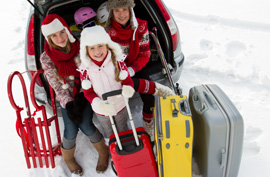 If you read travel publications and trawl the Web for packing tips, you can find millions of words of sometimes commonsensical, sometimes scolding and generally somewhat vague advice on how to pack for a winter trip. Don't pack too much stuff, dress in layers, pack a hat and gloves -- but you know all that stuff already.
If you read travel publications and trawl the Web for packing tips, you can find millions of words of sometimes commonsensical, sometimes scolding and generally somewhat vague advice on how to pack for a winter trip. Don't pack too much stuff, dress in layers, pack a hat and gloves -- but you know all that stuff already.
To help convert general packing advice into a usable packing list, I have some tricks you can use to help figure out where to start. We're not talking about packing for a ski trip -- that is its own special challenge -- but most travelers should find these tactics simple, straightforward and useful for a more general winter vacation.
Hats -- the Secret to Staying WarmBack when I used to go to concerts that weren't scheduled on Saturday mornings at 11 a.m., I went to a LOT of concerts, year round, mostly in the northeastern U.S. Wearing bulky clothes into a music bar, concert hall or jazz club isn't that different than doing the same on an airplane. I learned that a light fleece and a warm hat were all I needed to get from car to club, through the line and back again without freezing on a city street in February -- the same goes for sprints through airports, short walks for breakfast in the morning cold and more. If you don't want to freeze your bum off, wear a good hat.
Requirements for a good travel hat:
- Covers your ears
- At least partly covers the back of your neck
- Has no flaps, fluffballs or other wasted mass
- Is made of thin, modern materials for maximum warmth
There is nothing quite so brutal as a freezing cold noggin, so if you choose one item very carefully, make it your hat.
 Winter Travel: What You Need to Know
Winter Travel: What You Need to Know
Given that your feet are on the front line of most weather you will encounter, this is the one area that I recommend you be unafraid to go big. A solid, decent-looking pair of low-frills winter boots that you wear right onto the airplane will come through for you again and again during a winter trip.
Requirements for good winter travel shoes:
- Weatherproof -- Gore-Tex gear can be pretty styling these days
- Light on lacing -- you still need to get through security, so a pair of shoes or boots that can be worn loosely and don't require a lot of tying and untying will help
- Dark colored, so they won't show stains from mud, slush or getting thrown on filthy security belts
There are plenty of decent, affordable boots that hold up well enough to hike through snow in, but look good enough to wear to dinner; find them and wear them when you walk out the door for the airport.
Gloves -- Thin, Light, Breathable and WaterproofThe days of massive mittens and wool gloves are gone, at least for smart travelers; you can get a great pair of warm, waterproof, yet very thin gloves that weigh only a few ounces and will take up only a few square inches of your luggage. The breathability makes them wearable across a wide temperature range, the waterproofing makes them useful in the worst weather, and the tight packaging makes them very low impact both when packing and when carrying them around.
Here is what I use; they're great for everything from taking photos in the predawn cold to making good, strong snowballs: Sealskinz Waterproof Gloves.
Requirements for travel gloves:
- Weatherproof
- Breathable
- Extremely light and low bulk
- Quick drying
- Have some type of grip
Between your hat, boots and gloves, your vulnerable extremities are covered.
 Escape the Cold: Eight Warm Weather Winter Vacations
Escape the Cold: Eight Warm Weather Winter Vacations
 Almost every collection of tips on how to dress/pack/stay warm/etc. in winter includes advice to dress in layers -- which sounds great, but how do you go about it? Where do you start, and where do you stop? Without a plan, you could layer yourself up until you look like the Michelin man. To get a handle on how to pick and choose from the clothes you already own, try this trick.
Almost every collection of tips on how to dress/pack/stay warm/etc. in winter includes advice to dress in layers -- which sounds great, but how do you go about it? Where do you start, and where do you stop? Without a plan, you could layer yourself up until you look like the Michelin man. To get a handle on how to pick and choose from the clothes you already own, try this trick.
When traveling during winter, use a "morning paper" approach to figure out what to pack:
- Light long- or short-sleeve shirt (or T-shirt) for reading the paper indoors
- Long-sleeve top over that for grabbing the paper from the stoop
- Fleece (or sweater, though wool tends to be bulky) over that for getting the paper from the curb
- Light wind- and waterproof outer shell over that for getting the paper from the curb in the rain
If you pack such that you can get the paper in any weather, and then add and remove items as you go in and out of doors, you will have enough and the right clothes to layer up for pretty much any weather you will encounter, indoors or out.
Some Accessories to Consider- Polarized sunglasses: Even weaker winter sunlight, when reflected off snow, can be rough on your eyes. In addition, the sun is lower in the sky, so is more likely to be in your line of sight or become a problem when driving during the short daylight hours. In those conditions, polarized glasses perform extremely well.
- Sunscreen: Sunscreen in winter? Absolutely. A windburn, or a sunburn from reflection off of snow or ice, is every bit a rival of a summer sunburn.
- Lower-body base layer: If you are going to be spending extended time outdoors, consider packing a base layer to keep your legs comfortable in the cold. They are harder to shed than a top layer, but don't take up much packing space and are essential if you'll be outside for hours at a time.
- In harsher weather, a scarf can be a small and light but very effective addition.
 The Carry-On Challenge: How to Pack Light Every Time
The Carry-On Challenge: How to Pack Light Every Time
I have an oversized black wool jacket that I would take around the world if it didn't weigh about eight pounds and take up enough space to half-fill a suitcase. Every winter trip I look at it and think, yeah, it won't be that bad if I carry it on ... then I wise up.
The urge to pack your favorite stuff is a strong one; maybe look at those items last during the packing process, not first, and by then you will likely have made them unnecessary through your other, more logically considered choices.
Have any nuts and bolts packing tricks to add? Let us know in the comments.
Go Anyway,
Ed Hewitt
Features Editor
IndependentTraveler.com